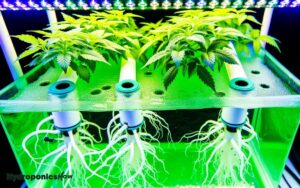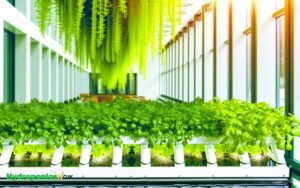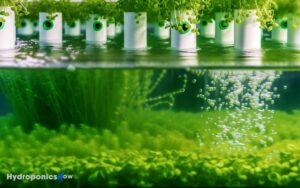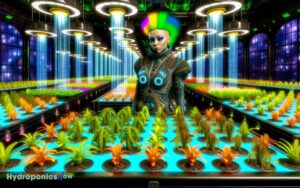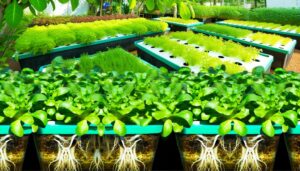Hydroponic Growth: How Big Do Plants Get?
In hydroponic systems, plant size varies due to multiple factors. Nutrient availability and light intensity are key; high nutrient levels and ample light boost growth greatly.
Water quality and pH, ideally between 5.5 to 6.5, enhance nutrient absorption. Temperature should stay around 70-75°F for best growth.
Proper spacing and pruning also help by ensuring each plant gets sufficient light and nutrients. Genetics play an important role, with hybrid varieties often bred for larger sizes.
By fine-tuning these elements, you can achieve impressive plant sizes. For a deeper understanding of these growth factors, continue reading.
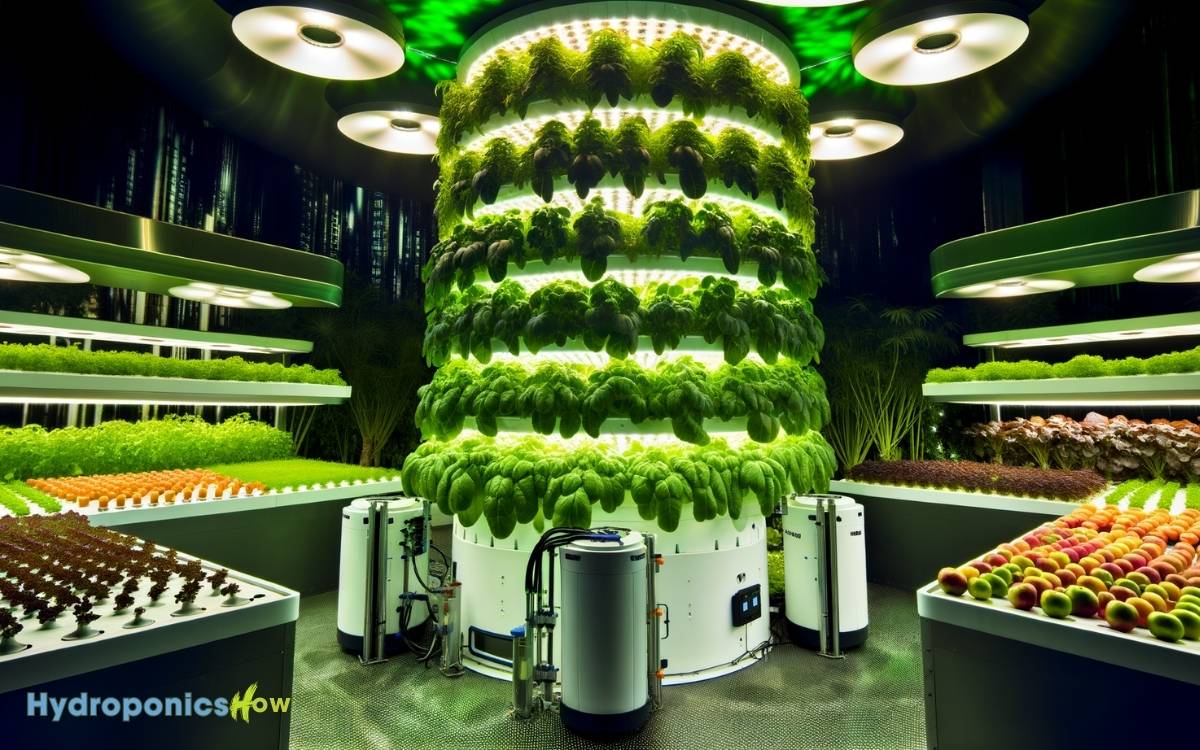
Key Takeaways
Factors Affecting Plant Size
Several key factors influence the size of hydroponic plants, including nutrient availability, light intensity, and water quality.
You’ll find that light intensity plays a crucial role, as it directly impacts photosynthesis. High light intensity promotes robust growth by enabling plants to synthesize more energy. Conversely, insufficient lighting can stunt plant development.
Water quality also greatly affects plant size. You should make sure the water is free from contaminants and has the appropriate pH level, typically between 5.5 and 6.5, to optimize nutrient uptake.
Contaminated or imbalanced water can inhibit growth by introducing harmful elements or causing nutrient lockout.
Nutrient Management
Effective nutrient management is crucial for maximizing the growth and health of hydroponic plants, as it ensures the precise delivery of essential minerals and elements.
You need to maintain an ideal nutrient solution concentration, typically measured by Electrical Conductivity (EC). Aim for an EC range of 1.5 to 2.5 mS/cm depending on the plant species.
Regularly monitor pH levels, ideally between 5.5 and 6.5. Nutrient imbalances can lead to deficiencies or toxicities, stunting growth. Use a balanced mix of macronutrients (N-P-K) and micronutrients (Fe, Mn, Zn, etc.) tailored to the plant’s growth stage.
Implementing a recirculating system can help maintain consistency. Regularly test and adjust your nutrient solution to promote robust and vigorous plant growth.
Light and Temperature
Proper light intensity and temperature control are crucial for optimizing the growth rate and size of hydroponic plants.
You’ll need to guarantee plants receive light in the ideal spectrum, typically between 400-700 nanometers, which encompasses both red and blue wavelengths. LED grow lights are highly effective due to their adjustable spectra and energy efficiency.
Temperature-wise, most hydroponic plants thrive between 70-75°F (21-24°C). Deviations can cause stress, stunting growth or even halting it. Utilize thermostats and fans to maintain stable temperatures.
Photoperiods also matter; flowering plants often need 12 hours of light and 12 hours of darkness.
Water Quality and Ph
Why is maintaining excellent water quality and the correct pH level crucial for hydroponic plant growth and size?
Water quality directly impacts nutrient absorption. Contaminants or high dissolved solids can block roots from accessing essential nutrients, leading to stunted growth.
Additionally, the pH level affects nutrient availability. Most hydroponic plants thrive in a pH range of 5.5 to 6.5. Outside this range, nutrients like nitrogen, phosphorus, and potassium become less soluble and harder for plants to uptake.
Monitoring and adjusting pH regularly guarantees that plants can access the full spectrum of nutrients. Use a reliable pH meter and adjust with pH up or down solutions as needed. This precision ensures ideal growth conditions, resulting in larger, healthier plants.
Space and Pruning
To optimize hydroponic plant size, you’ll need to manage plant density and implement effective vertical growth strategies. Evidence shows that proper spacing reduces competition for light and nutrients, enhancing overall plant health.
Additionally, employing precise pruning techniques can direct growth and improve yield quality.
Plant Density Management
Effective plant density management, achieved through strategic spacing and pruning, maximizes growth potential and resource efficiency in hydroponic systems. You need to make sure that each plant has sufficient access to light, nutrients, and air circulation.
Proper plant spacing allows for ideal photosynthetic activity, reducing competition for essential resources. Pruning helps in removing unnecessary foliage, promoting better airflow and preventing diseases.
Key considerations include:
- Plant Spacing: Maintain adequate gaps to maximize light penetration and nutrient distribution.
- Pruning Techniques: Regularly trim excess leaves to enhance airflow and reduce disease risk.
- Resource Allocation: Ensure each plant receives an ideal share of nutrients and light.
- Growth Monitoring: Routinely check plant health and adjust spacing and pruning as needed.
- Environmental Control: Manage temperature and humidity to support healthy growth.
Vertical Growth Strategies
Implementing vertical growth strategies in hydroponic systems maximizes space efficiency and enhances plant health through optimized pruning and spatial management.
You’ll find that utilizing vertical space not only allows for a higher density of plants but also reduces the footprint of your growing area.
Techniques like trellising, vertical towers, and stacking systems enable plants to grow upwards, making the most of available light and airflow.
Pruning plays a pivotal role in this approach, as it improves light penetration and air circulation, which are essential for plant development.
Evidence suggests that well-managed vertical systems can lead to increased yields and healthier plants, as they minimize stress factors like overcrowding and poor ventilation.
Pruning Techniques Explained
When you master proper pruning techniques, you greatly enhance light penetration and air circulation, which are crucial for the healthy development of hydroponic plants.
Effective pruning involves removing excess foliage and non-productive branches, enabling the plant to focus energy on fruitful growth.
Here are key techniques to explore:
- Topping: Cut the main stem to encourage bushier growth.
- Fimming: Pinch new growth tips to promote multiple new branches.
- Lollipopping: Remove lower leaves to concentrate growth in upper areas.
- Defoliation: Remove specific leaves to improve light access.
- Thinning: Space out branches to reduce overcrowding and enhance airflow.
These methods promote plant health, leading to robust growth and higher yields in your hydroponic system.
Plant Species and Varieties
You’ll need to ponder plant species and varieties carefully, as their growth rates and ultimate sizes vary greatly.
Popular hydroponic plants like lettuce, tomatoes, and herbs exhibit different growth patterns influenced by genetic factors and environmental conditions.
Utilizing a size comparison chart will help you predict and manage the spatial requirements for each type in your hydroponic system.
Popular Hydroponic Plants
Hydroponic gardening offers a diverse range of plant species and varieties, with leafy greens like lettuce and herbs such as basil being among the most popular choices due to their rapid growth and high yield in controlled environments.
You can also cultivate a wide array of other plants using hydroponic systems, which are designed to optimize nutrient delivery and growth conditions.
- Tomatoes: Thrive in hydroponic setups, producing abundant fruit.
- Cucumbers: Require trellising but yield heavily.
- Peppers: Benefit from precise nutrient control, leading to larger fruits.
- Strawberries: Produce berries year-round with the right conditions.
- Spinach: Grows quickly and benefits from hydroponic nutrient solutions.
These plants showcase the versatility and effectiveness of hydroponic gardening, allowing you to maximize both growth rate and yield.
Growth Rate Factors
The growth rate of hydroponic plants is significantly influenced by the species and varieties chosen, as each has specific nutrient and environmental requirements that must be meticulously managed.
For instance, leafy greens like lettuce and spinach typically exhibit rapid growth due to their high nutrient uptake efficiency.
Conversely, fruiting plants such as tomatoes and peppers demand more precise control over nutrient ratios and environmental conditions, resulting in varied growth rates.
Additionally, certain hybrid varieties are bred for accelerated growth and higher yields in hydroponic systems. The genetic makeup of the plant directly affects its metabolic rate, influencing how quickly it can convert nutrients into biomass.
Understanding these intricacies is essential for optimizing growth rates and achieving desired plant sizes in a hydroponic setup. By carefully monitoring factors such as nutrient concentrations, light exposure, and water pH, growers can create an ideal environment for plant development. A well-maintained hydroponic setup for cannabis ensures efficient nutrient uptake, leading to healthier plants and higher yields. Additionally, adjusting environmental variables like temperature and humidity can further enhance growth and prevent common issues such as mold or nutrient deficiencies.
Size Comparison Chart
When evaluating the sizes of different plant species and varieties in hydroponic systems, it’s crucial to analyze specific growth metrics such as height, leaf area, and biomass accumulation.
Understanding these metrics allows you to assess the potential yield and space requirements of each plant.
For instance, tomatoes and cucumbers typically achieve greater height and biomass compared to lettuce and herbs.
Here’s a detailed comparison chart to take into account:
- Tomatoes: Height: 6-10 feet, Leaf Area: 1.2 m², Biomass: 2-4 kg.
- Cucumbers: Height: 5-7 feet, Leaf Area: 1 m², Biomass: 1.5-3 kg.
- Lettuce: Height: 6-12 inches, Leaf Area: 0.2 m², Biomass: 150-200 grams.
- Basil: Height: 1-2 feet, Leaf Area: 0.3 m², Biomass: 200-300 grams.
- Strawberries: Height: 8-12 inches, Leaf Area: 0.1 m², Biomass: 250-400 grams.
This comparison helps you optimize your hydroponic setup for maximum efficiency and productivity.
Conclusion
In hydroponics, plant size can skyrocket when you master nutrient management, light, temperature, water quality, and pH. Don’t forget, space and pruning play vital roles too.
Tailor your techniques to specific plant species and varieties, and you’ll cultivate a garden that flourishes like a well-tuned orchestra. By understanding these factors, you’re not just growing plants; you’re engineering a thriving ecosystem.
Immerse yourself in these details, and watch your hydroponic garden reach for the stars.


